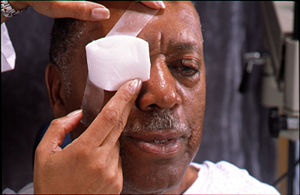Visual disturbance
(Redirected from Blurry vision)
Jump to navigation
Jump to search
Definition
Epidemiology
Differential Diagnosis
Visual loss is generally split up, at least with regards to a differential, in terms of time.
Acute (possibly)
These are the really important ones. If you don't identify them, then somebody might go blind - or die.
- Vascular causes - vein or artery
- Giant cell arteritis
- Retinal detachment
- Optic neuritis (ie. MS)
- TIA
- Closed-angle glaucoma
Not acute (probably)
- Diabetic retinopathy
- Cataract
- Wernicke's encephalopathy
- Macular degeneration
- Squint
- Amblyopia
- Cranial nerve palsies
- Optic tract disorders (inc. stroke)
- Papilloedema
- Hysterical visual loss - this is the least important thing you will ever learn about anything.
Clinical and Associated Features
Acute
- Retinal vein occlusion - painless unilateral visual loss like a "light dimming" or "shade coming down". Often noticed on waking. On fundoscopy: engorged veins; haemorrhage with 'cotton wool' exudates (infarcts); retinal oedema; swollen optic disc; new vessel proliferation; papilloedema; vitreous haemorrhage.
- Retinal artery occlusion - sudden visual loss in any possible field of vision. Uncommon but dangerous. Sudden, painless visual loss; poor direct light reflex, consensual is normal; pale and opaque retina; arteries pale, appear as red "threads"; fovea becomes "cherry red spot"; optic atrophy after a few weeks - optic disc goes white.
- Giant cell arteritis - headache, scalp tenderness, blurred/lost vision, fever
- Optic neuritis - inflammation of the optic nerve. Symptoms: variable central visual loss for 2-6 weeks; aching in region of the eye, aggravated by movement; central scotoma; loss of colour vision; relative afferent pupillary defect (RAPD); reduced visually-evoked response (a clever test)
- Closed-angle glaucoma - visual disturbance (leading to visual loss), eye pain (can be in the eye, around the orbit or just a generalised frontal headahce), nausea & vomiting. Often it's due to the pupil getting caught on the lens which blocks aqueous outflow. As such, it often happens when the pupil is mid-dilation e.g. during stress or excitement, watching TV in dim lighting, in patients on mydriatics.
- Wernicke's encephalopathy - if there's confusion and ataxia and the dude has a history of alcohol problems, think this.
Not acute
- Diabetic retinopathy - gradual visual deterioration; on fundscopy: microaneuryms, exudates, 'cotton wool' spots, haemorrhages, neovascularisation
- Age-related macular degeneration - gradual visual deterioration - usually starts with a central scotoma which gets bigger, causes difficulty with reading
- Cataracts - lens opacities. Gradual visual loss; difficulty reading, recognising faces, watching TV; diplopia (double vision)
- Papillloedema - bulging optic disc caused by raised ICP
- Squints - double vision, moving head to compensate
- Amblyopia/"lazy eye" - visual disturbance with no physical signs ("both the doctor and the patient see nothing")
- Optic tract disorders - this will usually be vascular or a tumour. Look for the visual defect
- Central nerve palsy - anything causing a palsy in nerves II, III, IV, V, VI could cause visual problems
Investigations
Generally, there are clever eye tests like visually-evoked responses and badass opthalmoscopy using clever machines but nothing particular.
